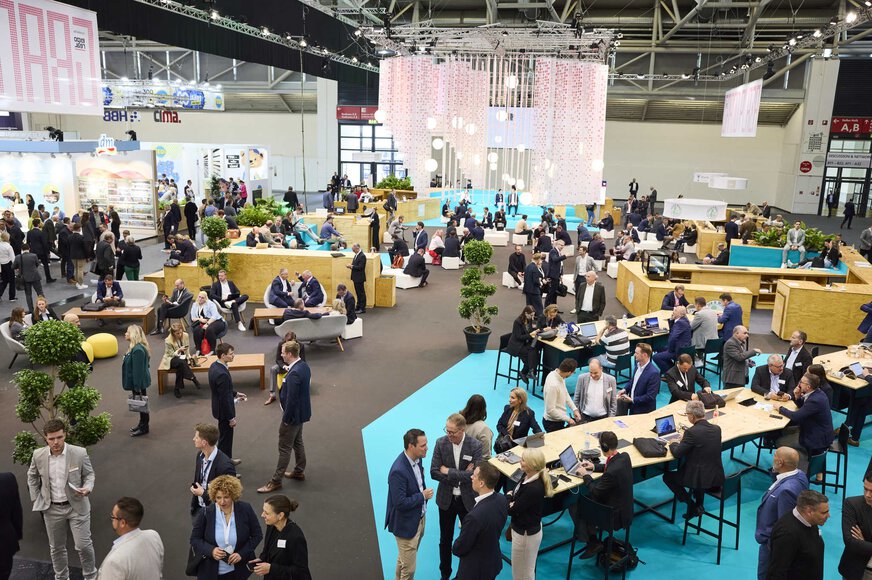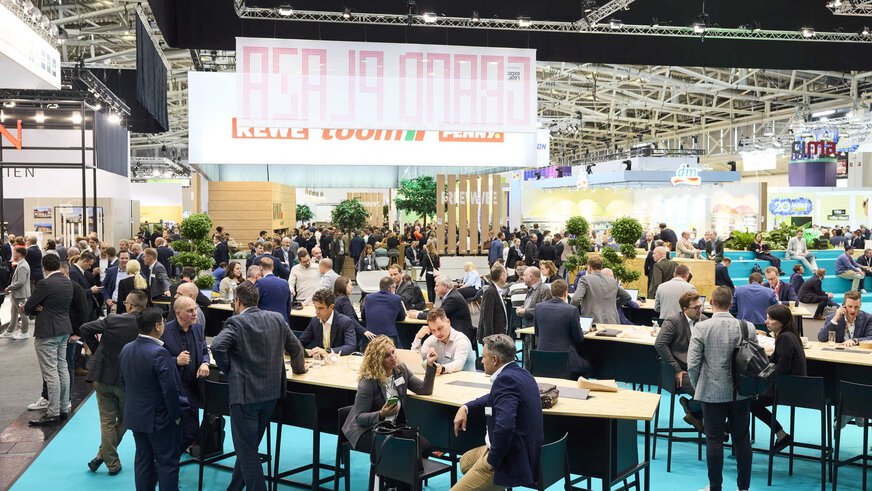Trade fair sector retail property: GRAND PLAZA—the marketplace for retail
EXPO REAL's GRAND PLAZA is a marketplace for all those involved in retail and retail properties to exchange ideas, discuss and find their way around the challenges and trends related to retail and retail properties.

What does EXPO REAL have to offer in the retail property segment?
The international trade fair for property and investment has established the GRAND PLAZA for all those involved in retail and retail real estate as a meeting place for retailers, investors and project developers, operators and representatives of potential locations. This is where anyone who wants to find out about the development of retail and retail property will find information and guidance—and the relevant contacts.
The GRAND PLAZA: Topics that move the industry
The GRAND PLAZA is also the stage for discussions on the hot retail topics. In 2024, the focus was on the transformation of city centers and the question of what will make our city centers attractive again in the future. Other topics included “Rents, terms, contracts” and the future of smart stores. Other topics were "rents, service charges, indexation" and the future of food suppliers. Experts discussed these challenges for retailers and everyone directly or indirectly involved in retail property.
GRAND PLAZA: make use of these advantages for your success!
- Everything in one place: many exhibitors from the retail property sector in the immediate vicinity of the GRAND PLAZA
- Networking: targeted networking with decision-makers and insiders of the retail industry
- New inspiration the conference program at the GRAND PLAZA is dedicated to the retail sector
- Attractive meeting place: GRAND PLAZA market stalls and an exclusive evening event on the first day of the show
GRAND PLAZA FORUM: where the future is discussed
The GRAND PLAZA conference program not only addressed current topics, but above all discussed strategies for the future—for example, future-proof cities and shopping centers and innovative concepts for retail properties in terms of ESG and sustainability.
Impressions of the GRAND PLAZA










Besides supermarket chains such as Edeka and Rewe, discounters such as Aldi Nord and Aldi Süd, Kaufland and Lidl, Netto and Penny, drugstore chains such as dm and Rossmann, the focus of exhibitors in the retail property sector at EXPO REAL 2024 included clothing chains such as Ernsting's Family, pet supplies such as Fressnapf, non-food-Discounter as Actions as well as toom Baumarkt—in other words, precisely those that are of interest to supermarkets, specialist stores and retail parks. EXPO REAL exhibitors also included shopping center operator ECE, as well as TREI Real Estate, two companies that are continuously expanding the network of retail parks, especially in CEE/SEE.

Retail property: one term for very different formats
Retail is not just retail, as reflected in the different retail properties. When thinking of retail, people often have inner-city retail, storefronts in shopping streets or at least in the immediate vicinity in mind. Yet here, too, the representative retail spaces for expensive upscale brands differ in terms of furnishings and size from those in which most people go shopping.
City centers, however, offer retail space not only to the right and left of the shopping streets, but also in shopping centers or shopping malls, which are meanwhile almost a must in any city, concentrating retail stores and services, often with the addition of culinary offerings, cinemas, fitness centers and other attractive crowd pullers. There are also department stores that offer a wide variety of goods, however, they are now often counted among the problem children of cities because they obviously no longer attract enough customers and the comparatively large areas are in danger of becoming deserted.
And then there is the "large-scale retail", requiring more than 800 square meters of space—furniture centers, electronics stores, DIY stores and similar, and also supermarkets with a full range of products. These large-scale retailers are not always in central locations and are often located on the outskirts of cities. Both here and in the surrounding areas of medium-sized and smaller cities, an increasing number of retail parks have been emerging in recent times—a collection of different retail sectors, often with a large supermarket or discounter as the anchor tenant and other stores serving local supplies. These retail parks usually consist of a large complex of buildings and are managed and marketed by one operator.
Retail property: an increasingly difficult market
Retail has been in crisis for some time now, especially the growing e-commerce sector is putting pressure on stationary retail stores. Responding to this competition costs time and money. What is needed are multi-channel concepts that consider the changed customer behavior in the digital age.
How has the pandemic affected the market for retail properties?
The COVID-19 pandemic and its lockdowns have exacerbated the challenges. While large parts of stationary retail stores had to close, online commerce boomed stronger than ever. With the end of the pandemic and a largely normalized life, retailers hoped for a new upswing, but the war in Ukraine, the resulting energy crisis, and rapid inflation continued to shrink revenues. In fact, many retailers had to give up their business in the wake of the pandemic, and even major chains subjected their locations to strict assessment and permanently closed around 30 percent of their locations.
Weak consumption - a permanent hurdle?
The situation in city centers continues to deteriorate. According to a forecast by the German Retail Association (HDE), another 5,000 stores will close their doors for good in 2024.
One reason for this is economic and political uncertainty among consumers, who are showing little inclination to spend money despite real wage increases. In fact, a significant improvement in consumer sentiment is not expected in the foreseeable future. However, according to the GfK, there are also no signs of a further slump in consumption.
What does the market for retail properties look like?
Despite these negative trends, the market for retail properties recorded its best letting volume since 2019 in 2023 with around 540,000 square meters in city center locations (2020: 420,000 square meters; 2021: 470,000 square meters; 2022: 390,000 square meters). The downward trend in take-up appears to have come to a halt. This is partly due to a greater willingness to compromise on the part of landlords with regard to contract design and risk sharing, and partly because many retailers have taken advantage of the changed supply structure - numerous spaces that have been vacant for some time and impending vacancies. In addition, rents have fallen significantly after peaking in 2019 and have largely stabilized at the low level of 2021 (BNP PARIBAS REAL ESTATE).
While retail assets were long sought-after investment properties among commercial real estate, they owe their second place after logistics properties in 2023 to the fact that investments in office properties have declined even more sharply. 5.4 billion flowed into retail properties last year - over 40% less than in 2022.
Investors are currently increasingly focusing on specialist and food stores as well as local supply and retail parks. These assets accounted for 59% of the transaction volume. They have the advantage of mostly serving short-term needs and are therefore less susceptible to fluctuations in the consumer climate. Tenants are often well-established chain stores that guarantee a stable long-term cash flow. And what also makes these properties attractive in times of high financing costs: unlike large shopping centers, the prices are usually below the 50 million euro mark.
Although prime retail properties were also able to increase their share of the transaction volume - this share rose from 15% in 2022 to a good 30% - the sale of shares in the eight department stores of Signa Prime Selection and the sale of shares in prominent department stores such as KaDeWe in Berlin also contributed to this.

Where the journey is going: the future of retail property
The retail sector, and with it the market for retail properties, is in a state of upheaval. In particular, online commerce has had a disruptive effect here. Consumers have quickly become used to these digital options—not only to being able to order and have their orders delivered quickly, but also to being able to compare prices more quickly via the internet. Retailers have now adapted to this and not only offer their goods in stationary stores, but also use all digital channels—the buzzword being omnichannel—to market products and build customer loyalty. This change has however not been without consequences. Not only department stores have become problem children, because the closure of these properties means that large buildings in prominent locations in the cities are now more likely to be vacant. Even shopping centers are often struggling, despite all the attempts to attract people by offering a wider range of culinary and leisure amenities. What is particularly striking is that the intervals between efforts to adapt these temples of consumption to the ever more rapidly changing demands of customers are becoming increasingly shorter.
What is the future of retail real estate?
Yet, it is not only the change in consumer behavior that is causing problems for retailers and thus for the owners and operators of retail assets. Since the COVID-19 pandemic, many of the international chains have revised their previous expansion strategies, with the result that some locations have been closed and others have been turned into flagship stores. This as well causes the demand for space to decrease.
Even if the fancy shopping miles in the big cities at least prove to be more resistant than others, experience from the pandemic, during which the wealthy tourists stayed away but the local population often cannot and will not afford the prices charged, shows that even these high-street stores, for which significantly higher rents still have to be paid, do not or cannot always generate the corresponding sales.
Accordingly, a certain degree of streamlining is likely to be taking place in downtown shopping streets, with the specter of the "dying city center" seemingly omnipresent, if somewhat exaggerated, in discussions about retail and retail real estate. We can already observe that empty store spaces are often transformed into restaurants, and that where the chains leave a gap, other offers and services are established. Retail is changing and with it the city centers. In the future, it will certainly no longer be as easy to rent out every retail store at high prices. Maybe we will see a return of the small stores that in the past tended to be pushed to the periphery, there may be more other uses, but ultimately the city center will continue to be a center of urban life.
However, the city center is only one location for retail properties. For a long time, it was more or less the only location and the surrounding districts and communities offered rather few shopping opportunities, but at least this "shortage situation" has changed fundamentally. In recent years, more and more supermarkets have popped up like mushrooms there, guaranteeing at least local supplies. Even in small towns, more and more retail parks are being built, which on the one hand serve local supply, but on the other hand also offer a range of clothing and/or sporting goods, going beyond supermarkets, discounters and drugstores. Large-scale retailers such as DIY stores, garden centers, furniture stores and even large consumer electronics centers, which are unable to find suitable space in urban locations at prices that are affordable for them, tend to remain solitary entities.
The separation into downtown retail and commercial establishments in "secondary locations" will likely continue, with urban planners aiming for the 15-minute city, a well-diversified city where everything necessary is within a 15-minute walk of any residential location. Thus, not only local supply centers are needed in the city districts, but also shopping facilities and services that go beyond them. In line with this, some cities are specifically supporting the establishment of local retailers and service providers in urban districts. In other words: the retail sector and retail locations will further differentiate, but will presumably also become increasingly small-scale as a result.
Challenges in the retail property market
The greatest challenge currently facing the retail sector is economic development because energy prices and inflation are restricting consumers' scope for consumption. After hitting a low in the fall of last year, however, consumer sentiment appears to be improving gradually, not least due to the more favorable economic forecasts. When consumption stabilizes, the pressure on rents for retail properties is also likely to ease and demand for space will pick up.
Where is the market for retail properties headed?
However, the days of long-term rent contracts are over, and soon it will not be possible to rent out every store space again quickly and at every price. Almost every city now has vacant spaces, and even shopping centers see some vacancies. This is where ideas need to be developed on how these areas can be repurposed.
For instance, one or the other shopping center has already been converted into a health center, or there are considerations to use larger areas for city logistics. Particularly in the city center, retail properties will need to demonstrate greater imagination and flexibility in their use in the future.
Things look different when it comes to specialist stores and retail parks, which are preferred investment properties at the moment, not without reason. Specialty stores—electronics stores, furniture centers, DIY stores, garden centers, etc.—are relatively "location bound", i. e., these leases have a longer term. And retail parks primarily serve local supply, with grocery stores and drugstores, i. e., what everyone needs and which has not suffered any slump even in times of pandemic, being supplemented by other, more reasonably priced offerings. This is the area of retail that is perhaps not quite as prestigious as high-street locations, but which generates comparatively stable rents over the long term.
In the impressions section you will find more impressions from EXPO REAL.
